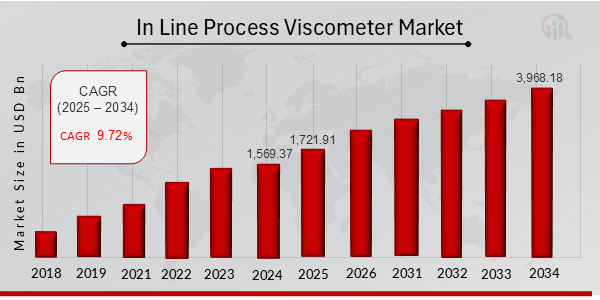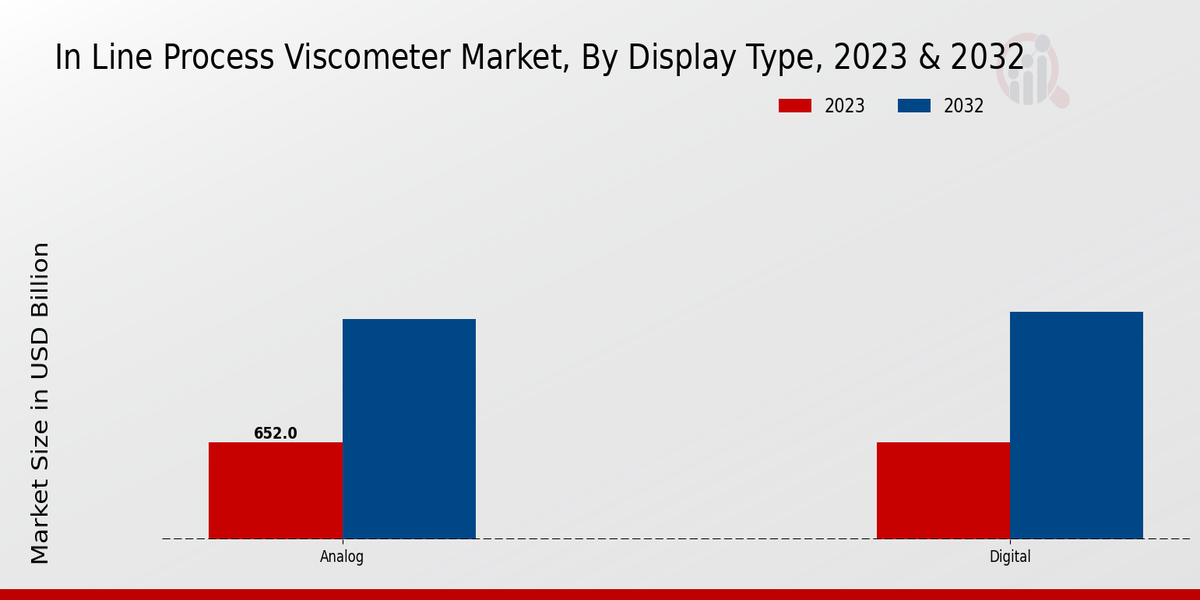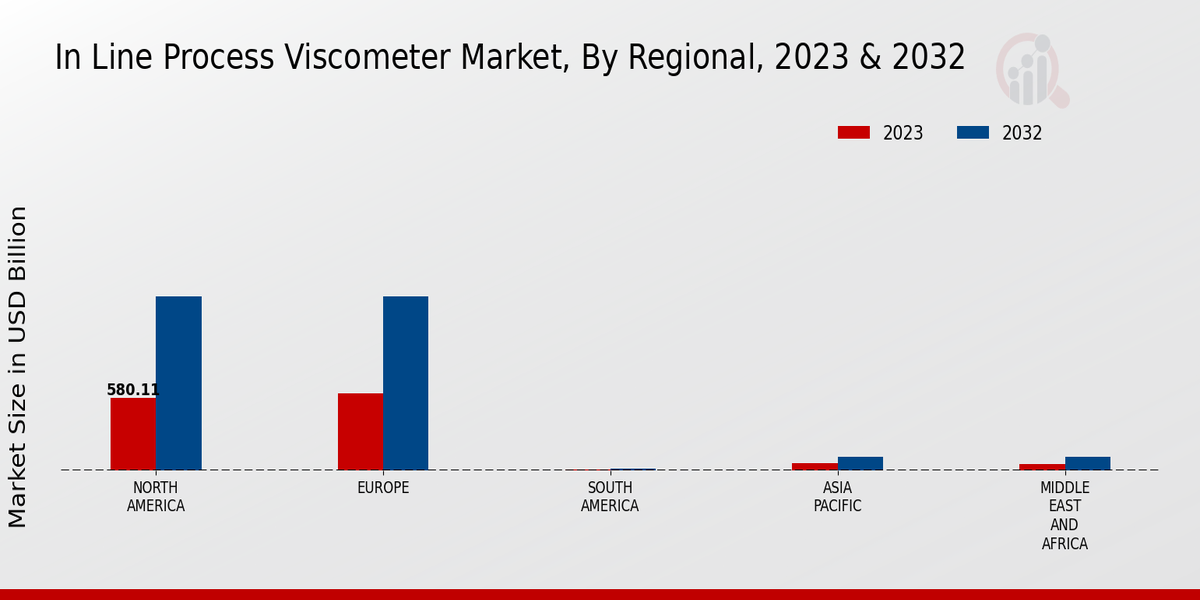In Line Process Viscometer Market Overview
As per MRFR analysis, the In Line Process Viscometer Market Size was estimated at 1,569.37 (USD Billion) in 2024. The In Line Process Viscometer Market Industry is expected to grow from 1,721.91 (USD Billion) in 2025 to 3,968.18 (USD Billion) till 2034, at a CAGR (growth rate) is expected to be around 9.72% during the forecast period (2025 - 2034)
Key In Line Process Viscometer Market Trends Highlighted
Key market drivers for the inline process viscometer market include increasing demand for real-time viscosity monitoring in various industries, growing awareness of the importance of viscosity control, and advancements in sensor technology. The rising adoption of automation and digitalization in manufacturing processes also presents significant growth opportunities.
Recent trends in the inline process viscometer market include the integration of artificial intelligence (AI) and machine learning (ML) algorithms, enabling predictive maintenance and improved process control. The development of non-invasive and low-maintenance viscometers is also gaining traction. Major players are focusing on strategic partnerships and collaborations to expand their product offerings and geographical reach. Additionally, the market is expected to benefit from the increasing adoption of inline process viscometers in emerging economies, where there is a growing demand for quality control and process optimization.
Figure1: In Line Process Viscometer Market, 2025 - 2034 (USD Billion)

Source: Primary Research, Secondary Research, MRFR Database and Analyst Review
In Line Process Viscometer Market Drivers
Increasing Demand for In-Line Process Viscometers in the Chemical Industry
The chemical industry is one of the largest consumers of in-line process viscometers. These devices are used to measure the viscosity of liquids and slurries in real time, which is critical for ensuring product quality and process efficiency. In recent years, the demand for in-line process viscometers has increased significantly in the chemical industry due to several factors. First, the chemical industry is becoming increasingly automated, and in-line process viscometers play a key role in this automation. These devices can be integrated into automated control systems to monitor and adjust the viscosity of liquids and slurries in real time.
This helps to improve product quality and process efficiency, and it can also reduce production costs. Second, the chemical industry is facing increasing pressure to reduce its environmental impact. In-line process viscometers can help reduce the environmental impact of the chemical industry by monitoring and controlling the viscosity of wastewater. This helps to ensure that wastewater meets environmental regulations and it can also reduce the amount of water that is used in the chemical manufacturing process. Third, the chemical industry is facing increasing competition from markets. In order to compete effectively, chemical companies need to be able to produce high-quality products at a low cost.
In-line process viscometers can help to improve product quality and reduce production costs, which can give chemical companies a competitive advantage in the market. Overall, the increasing demand for in-line process viscometers in the chemical industry is being driven by the need for improved product quality, process efficiency, environmental compliance, and cost reduction. This demand is expected to continue to grow in the coming years as the chemical industry continues to automate and ize.
Growing Adoption of In-Line Process Viscometers in the Food and Beverage Industry
The food and beverage industry is another major consumer of in-line process viscometers. These devices are used to measure the viscosity of liquids and slurries in real time, which is critical for ensuring product quality and process efficiency. In recent years, the adoption of in-line process viscometers in the food and beverage industry has increased significantly due to several factors. First, the food and beverage industry is becoming increasingly automated, and in-line process viscometers play a key role in this automation. These devices can be integrated into automated control systems to monitor and adjust the viscosity of liquids and slurries in real time. This helps to improve product quality and process efficiency, and it can also reduce production costs.
Second, the food and beverage industry is facing increasing pressure to reduce its environmental impact. In-line process viscometers can help reduce the environmental impact of the food and beverage industry by monitoring and controlling the viscosity of wastewater. This helps to ensure that wastewater meets environmental regulations and it can also reduce the amount of water that is used in the food and beverage manufacturing process.
Third, the food and beverage industry is facing increasing competition from markets. In order to compete effectively, food and beverage companies need to be able to produce high-quality products at a low cost. In-line process viscometers can help to improve product quality and reduce production costs, which can give food and beverage companies a competitive advantage in the market. Overall, the growing adoption of in-line process viscometers in the food and beverage industry is being driven by the need for improved product quality, process efficiency, environmental compliance, and cost reduction.This adoption is expected to continue to grow in the coming years as the food and beverage industry continues to automate and ize.
Rising Adoption of In-Line Process Viscometers in the Pharmaceutical Industry
The pharmaceutical industry is another major consumer of in-line process viscometers. These devices are used to measure the viscosity of liquids and slurries in real time, which is critical for ensuring product quality and process efficiency. In recent years, the adoption of in-line process viscometers in the pharmaceutical industry has increased significantly due to several factors.
First, the pharmaceutical industry is becoming increasingly automated, and in-line process viscometers play a key role in this automation. These devices can be integrated into automated guided vehicle control systems to monitor and adjust the viscosity of liquids and slurries in real time. This helps to improve product quality and process efficiency, and it can also reduce production costs. Second, the pharmaceutical industry is facing increasing pressure to reduce its environmental impact. In-line process viscometers can help reduce the environmental impact of the pharmaceutical industry by monitoring and controlling the viscosity of wastewater. This helps to ensure that wastewater meets environmental regulations and it can also reduce the amount of water that is used in the pharmaceutical manufacturing process. Third, the pharmaceutical industry is facing increasing competition from markets.
In order to compete effectively, pharmaceutical companies need to be able to produce high-quality products at a low cost. In-line process viscometers can help improve product quality and reduce production costs, which can give pharmaceutical companies a competitive advantage in the market. Overall, the rising adoption of in-line process viscometers in the pharmaceutical industry is being driven by the need for improved product quality, process efficiency, environmental compliance, and cost reduction. This adoption is expected to continue to grow in the coming years as the pharmaceutical industry continues to automate and ize.
In Line Process Viscometer Market Segment Insights
In Line Process Viscometer Market Display Type Insights
Analog and digital display types are the two main categories of in-line process viscometers. Analog viscometers use a mechanical dial to indicate the viscosity of the fluid, while digital viscometers use a digital display to show the viscosity. The growth of the market is attributed to the increasing demand for in-line process viscometers in various industries, such as oil and gas, chemicals, food and beverage, and pharmaceuticals. Analog viscometers are typically less expensive than digital viscometers, but they are also less accurate and precise.
Digital viscometers are more expensive, but they offer a higher level of accuracy and precision. The choice between an analog or digital viscometer will depend on the specific application. In the in-line process viscometer market, the digital display type segment is expected to grow at a higher CAGR than the analog display type segment. The growth of the digital display type segment is attributed to the increasing demand for digital viscometers in various industries. Digital viscometers offer a higher level of accuracy and precision than analog viscometers, and they are also easier to use.
Figure2: In Line Process Viscometer Market, By Display Type, 2023 & 2032 (USD billion)

Source: Primary Research, Secondary Research, MRFR Database and Analyst Review
In Line Process Viscometer Market Application Insights
The In Line Process Viscometer Market is segmented by Application into Industrial, Pharmaceutical, Food, Beverage, and Chemical. The Industrial segment held the largest market share in 2023, accounting for around 45% of the In Line Process Viscometer Market revenue. This segment is expected to continue to dominate the market over the forecast period, owing to the increasing demand for in-line process viscometers in various industrial applications, such as manufacturing, oil gas, and power generation. The pharmaceutical segment is also expected to witness significant growth over the forecast period due to the rising demand for in-line process viscometers for the production of pharmaceuticals and biopharmaceuticals.
The food and beverage segment is expected to grow at a steady pace over the forecast period, driven by the increasing demand for in-line process viscometers for the production of food and beverages. The chemical segment is also expected to experience growth over the forecast period, owing to the rising demand for in-line process viscometers for the production of chemicals and petrochemicals.
In Line Process Viscometer Market Measurement Technique Insights
The measurement technique segment of the In Line Process Viscometer Market is categorized into rotational, oscillatory, and ultrasonic techniques. Rotational viscometers measure viscosity by applying a known force to a rotating spindle immersed in the fluid, while oscillatory viscometers measure viscosity by applying a known force to a vibrating probe immersed in the fluid. Ultrasonic viscometers measure viscosity by measuring the speed of sound waves traveling through the fluid. In 2023, the rotational viscometer segment accounted for the largest share of the In Line Process Viscometer Market, with a market value of USD 1,250.4 million.
The rotational viscometer segment is expected to continue to dominate the market over the forecast period, with a projected market value of USD 2,182.4 million by 2032. The growth of the rotational viscometer segment is attributed to its high accuracy and wide applicability in various industries.
The oscillatory viscometer segment is expected to witness significant growth over the forecast period, with a projected market value of USD 675.6 million by 2032. The growth of the oscillatory viscometer segment is attributed to its ability to measure the viscoelastic properties of fluids, which is important in various industries, such as the food and beverage industry.
The ultrasonic viscometer segment is expected to experience modest growth over the forecast period, with a projected market value of USD 342.0 million by 2032. The growth of the ultrasonic viscometer segment is attributed to its non-invasive nature and ease of use.
In Line Process Viscometer Market Regional Insights
The In Line Process Viscometer Market is segmented into regions such as North America, Europe, APAC, South America, and MEA. Among these regions, APAC is expected to witness significant growth in the coming years. The growing demand for inline process viscometers from various industries such as food, beverage, pharmaceuticals, and chemicals is driving the market growth in this region. North America and Europe are also expected to contribute significantly to the In Line Process Viscometer Market revenue due to the presence of well-established players and the increasing adoption of advanced technologies.
The market in South America and MEA is expected to grow at a steady pace due to rising industrialization and infrastructure development. Regional market segmentation provides valuable data for businesses to understand the specific dynamics and opportunities in each region.
Figure3: In Line Process Viscometer Market, By Regional, 2023 & 2032 (USD billion)

Source: Primary Research, Secondary Research, MRFR Database and Analyst Review
In Line Process Viscometer Market Key Players And Competitive Insights
Major players in In Line Process Viscometer Market industry are constantly innovating and developing new technologies to gain a competitive edge. Leading In Line Process Viscometer Market players are focusing on expanding their product portfolio and geographical reach to cater to the diverse needs of customers. The In Line Process Viscometer Market development is driven by the increasing demand for real-time and accurate viscosity measurement in various industries. The competitive landscape of the In Line Process Viscometer Market is characterized by the presence of both established and emerging players.A prominent competitor in the In Line Process Viscometer Market is Anton Paar.
The company offers a wide range of viscometers, including rotational, capillary, and falling ball viscometers. Anton Paar's viscometers are known for their precision, accuracy, and reliability. The company has a strong presence and a wide distribution network. Another key competitor in the In Line Process Viscometer Market is Brookfield Engineering Laboratories. Brookfield offers a comprehensive line of viscometers for a variety of applications. The company's viscometers are used in various industries, including food, pharmaceuticals, and cosmetics. Brookfield has a strong reputation for quality and innovation.Another major player in the In Line Process Viscometer Market is Thermo Fisher Scientific.
The company offers a range of viscometers, including rotational, capillary, and falling ball viscometers. Thermo Fisher Scientific's viscometers are used in a variety of applications, including research and development, quality control, and manufacturing. The company has a strong presence and a wide distribution network.
Key Companies in the In Line Process Viscometer Market Include
In Line Process Viscometer Market Industry Developments
The In Line Process Viscometer Market is projected to reach USD 3,968.18 billion by 2034, exhibiting a CAGR of 9.72% during the forecast period (2025-2034). Growing demand for accurate and real-time viscosity measurement in various industries, including pharmaceuticals, chemicals, and food and beverage, is driving market growth.
Technological advancements such as the integration of sensors and automation are further enhancing the capabilities and efficiency of in-line process viscometers. Key players in the market are focusing on strategic partnerships, mergers, and acquisitions to expand their footprint and product offerings. Recent news developments include the launch of new viscometer models with advanced features by companies like Anton Paar and Brookfield Engineering Laboratories.
In Line Process Viscometer Market Segmentation Insights
In Line Process Viscometer Market Display Type Outlook
In Line Process Viscometer Market Application Outlook
- Industrial
- Pharmaceutical
- Food Beverage
- Chemical
In Line Process Viscometer Market Measurement Technique Outlook
- Rotational
- Oscillatory
- Ultrasonic
In Line Process Viscometer Market Regional Outlook
- North America
- Europe
- South America
- Asia Pacific
- Middle East and Africa
| Report Attribute/Metric |
Details |
|
Market Size 2024
|
1,569.37 (USD Billion)
|
|
Market Size 2025
|
1,721.91 (USD Billion)
|
|
Market Size 2034
|
3,968.18 (USD Billion)
|
|
Compound Annual Growth Rate (CAGR)
|
9.72% (2025 - 2034)
|
|
Report Coverage
|
Revenue Forecast, Competitive Landscape, Growth Factors, and Trends
|
|
Base Year
|
2024
|
|
Market Forecast Period
|
2025 - 2034
|
|
Historical Data
|
2019 - 2023
|
| Market Forecast Units |
USD Billion |
| Key Companies Profiled |
Herzog, TA Instruments, Chandler Engineering, HAAKE, Julabo GmbH, Anton Paar, Fluid Dynamics Ltd., Oberndorfer Pumpe, Cambridge Viscometers, Ruska Instrument Group, Malvern Panalytical, Brookfield Engineering Laboratories, Rheonics, Inc., Convatech, Inc, Thermo Fisher Scientific |
| Segments Covered |
Display Type, Application, Measurement Technique, Regional |
| Key Market Opportunities |
1 Rising demand in the pharmaceutical industry2 Growing adoption in the oil and gas sector3 Surge in the food and beverage industry4 Technological advancements5 Increasing environmental regulations |
| Key Market Dynamics |
Increasing demand from the food and beverage industryGrowing adoption of chemical processingTechnological advancements in sensor technologyStringent government regulationsRising awareness of product quality control |
| Countries Covered |
North America, Europe, APAC, South America, MEA |
Frequently Asked Questions (FAQ) :
The In Line Process Viscometer Market is valued at USD 1,569.37 billion in 2024 and is projected to reach USD 3,968.18 billion by 2034, exhibiting a CAGR of 9.72% during the forecast period (2025-2034).
Asia-Pacific is anticipated to dominate the In Line Process Viscometer Market throughout the forecast period due to the increasing demand for in-line process viscometers in various industries such as oil, gas, chemicals, and pharmaceuticals.
The growing demand for real-time monitoring and control of viscosity in various industrial processes, advancements in sensor technology, and the increasing adoption of automation in industries are the primary factors propelling the growth of the In Line Process Viscometer Market.
In Line, Process Viscometers find extensive applications in diverse industries, including oil gas, chemicals, pharmaceuticals, food beverages, and water treatment, for real-time monitoring and control of fluid viscosity in pipelines and process streams.
Key players in the In Line Process Viscometer Market include ABB, Anton Paar GmbH, Brookfield Engineering Laboratories, Inc., Endress+Hauser, GE Measurement Control, Honeywell International Inc., Malvern Panalytical Ltd., Mettler Toledo International Inc., Rheonics, and Siemens AG.
The high cost of in-line process viscometers and the need for skilled personnel to operate and maintain them pose significant challenges to the growth of the market.
Growing demand for in-line process viscometers in emerging economies, technological advancements in sensor technology, and increasing adoption of automation in industries present lucrative opportunities for growth in the market.
The integration of advanced sensors and technologies, such as IoT and AI, the development of wireless and portable in-line process viscometers, and the growing focus on energy efficiency and sustainability are key trends shaping the market.
Economic downturns, fluctuations in raw material prices, intense competition, and technological disruptions pose potential risks to the growth of the In Line Process Viscometer Market.
Advancements in sensor technology, the integration of IoT and cloud computing, the development of self-calibrating and self-cleaning in-line process viscometers, and increasing adoption in new applications are anticipated future developments in the market.

















